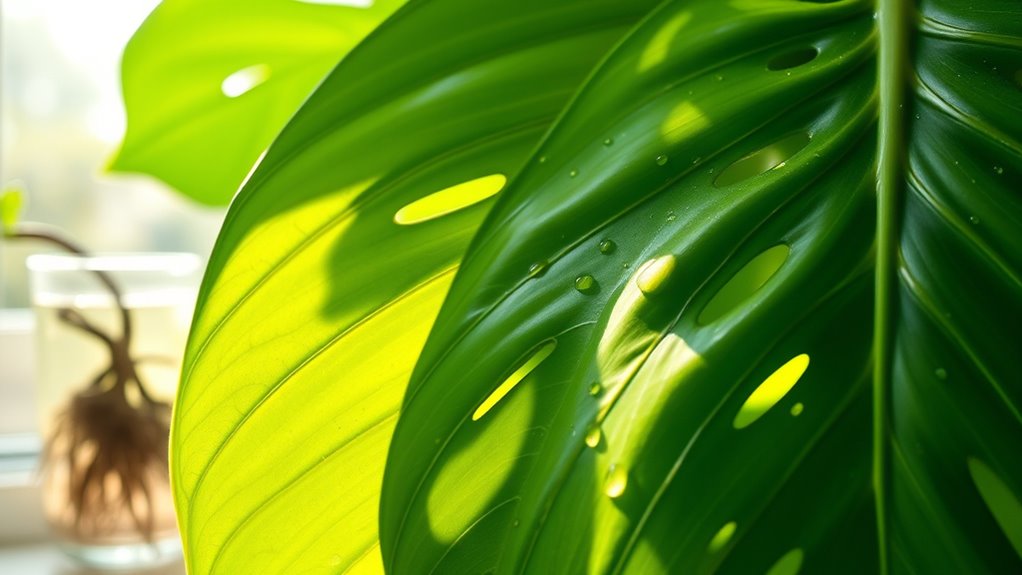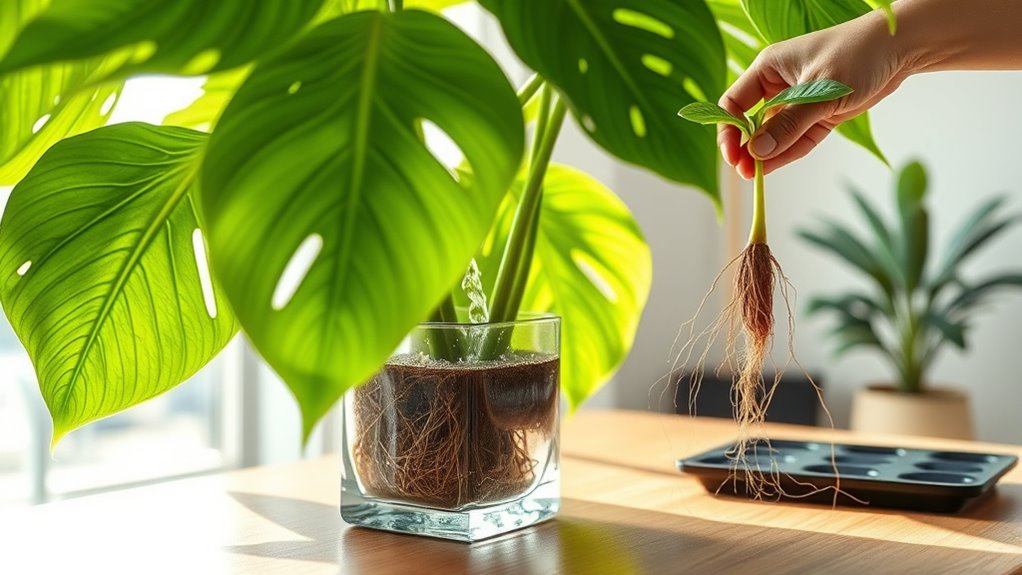To care for your Monstera deliciosa, place it near bright, indirect light to prevent leaf scorch, and water weekly in warm months, reducing to ten days in cooler seasons—ensure the top inch of soil stays moist without becoming soggy. Prune dead leaves to promote healthy growth and improve airflow. For propagation, cut a stem with a node and place it in water or soil. Following these tips will help your Monstera thrive and flourish—there’s more to discover for ideal care.
Key Takeaways
- Provide bright, indirect light and avoid direct sunlight to prevent leaf scorch.
- Keep soil consistently moist, watering weekly in warm months and less in cooler seasons.
- Use room temperature water and check soil moisture regularly to prevent over- or under-watering.
- Prune yellow or dead leaves with clean tools to promote healthy growth and prevent disease.
- Propagate Monstera deliciosa through stem cuttings with nodes, placing them in water or soil for roots.

Are you wondering how to keep your Monstera Deliciosa thriving? The key lies in understanding its basic needs, especially when it comes to monstera watering and monstera pruning. Proper watering ensures your plant remains healthy and vibrant, while occasional pruning helps promote new growth and keeps your Monstera looking its best. When it comes to monstera watering, it’s essential to strike a balance. You want to keep the soil consistently moist but not waterlogged, as too much water can lead to root rot. Check the top inch of soil; if it feels dry, it’s time to water. During warmer months, your Monstera might need watering once a week, but in cooler seasons, cut back to every ten days or so. Always use room temperature water, and avoid letting your plant sit in standing water, which can suffocate the roots. Incorporating data-driven strategies can help monitor and optimize the watering schedule for your Monstera’s specific needs.
In addition to watering, monstera pruning plays a crucial role in maintaining a healthy plant. Regularly trim away yellowing or dead leaves to prevent disease and improve airflow around the plant. Use clean, sharp scissors or pruning shears to make clean cuts, and always cut just above a leaf node or stem junction. Pruning also helps control the size and shape of your Monstera, encouraging it to grow fuller and more vigorously. If you notice any damaged or crowded stems, don’t hesitate to remove them; this directs energy toward healthy growth. Keep in mind that pruning isn’t just about aesthetics—it’s about the overall health of your plant.
Beyond watering and pruning, providing the right environment will help your Monstera flourish. It prefers bright, indirect light, so place it near a window where it can get plenty of filtered sunlight. Avoid direct sunlight, which can scorch its leaves. Consistent watering, combined with thoughtful pruning, will support its growth and keep it looking lush. Remember, your Monstera is a living organism that responds well to attentive care. By monitoring its watering needs and trimming when necessary, you’re giving it the best chance to grow into a stunning, tropical statement piece in your home. With patience and regular maintenance, your Monstera Deliciosa will reward you with vibrant foliage and a healthy, flourishing presence.
Frequently Asked Questions
How Do I Identify if My Monstera Deliciosa Is Overwatering?
You can tell if your monstera deliciosa is overwatering by looking for leaf discoloration, like yellowing or browning, and signs of root rot. When roots sit in soggy soil, they decay, causing the plant to weaken. Check the soil moisture regularly; if it’s consistently wet, reduce watering. Overwatering often leads to root rot, so addressing these signs early helps keep your plant healthy.
What Are the Signs of Underwatering in Monstera Deliciosa?
If your monstera deliciosa is underwatered, you’ll notice leaf discoloration, especially browning or yellowing edges, and wilting stems that droop or feel limp. You might also see dry, brittle leaves that struggle to recover. To fix this, water thoroughly when the top inch of soil feels dry, ensuring your plant gets consistent moisture. Regularly check your monstera to catch signs early and keep it healthy.
Can Monstera Deliciosa Survive in Low-Light Conditions?
Did you know that Monstera deliciosa can survive in low-light conditions, but its growth slows considerably? You should focus on indoor lighting and plant placement to keep it healthy. While it tolerates shaded spots, placing it near a bright window or in well-lit corners encourages lush foliage. If natural light is limited, consider using grow lights to supplement, ensuring your Monstera stays vibrant and thriving.
What Soil Type Is Best for Monstera Propagation?
You should use a well-draining soil mixture for monstera propagation to guarantee healthy root development. A mix of peat, perlite, and orchid bark provides excellent drainage capacity, preventing waterlogging. This combination allows air to reach the roots and keeps moisture balanced. When propagating, choose soil that’s light and airy, which helps the cuttings establish quickly and reduces the risk of rot.
How Long Does It Take for Propagated Monstera to Root?
You can expect your propagated monstera to root within 2 to 6 weeks, depending on conditions like humidity and temperature. During this rooting time, you’ll want to watch for new roots emerging, indicating successful propagation. Patience is key, as consistent moisture and proper care boost your chances of propagation success. Keep an eye on your cutting, and soon you’ll see those roots grow, signaling it’s time for the next step.
Conclusion
Think of your Monstera deliciosa as a delicate symphony, where light, water, and patience harmonize to create a lush masterpiece. When you nurture it with care, you’re conducting a living orchestra that flourishes and thrives under your guidance. With each well-timed watering and gentle touch, you become the maestro of its growth. Keep tending to it with love, and your plant will reward you with vibrant leaves, transforming your space into a verdant sanctuary.









